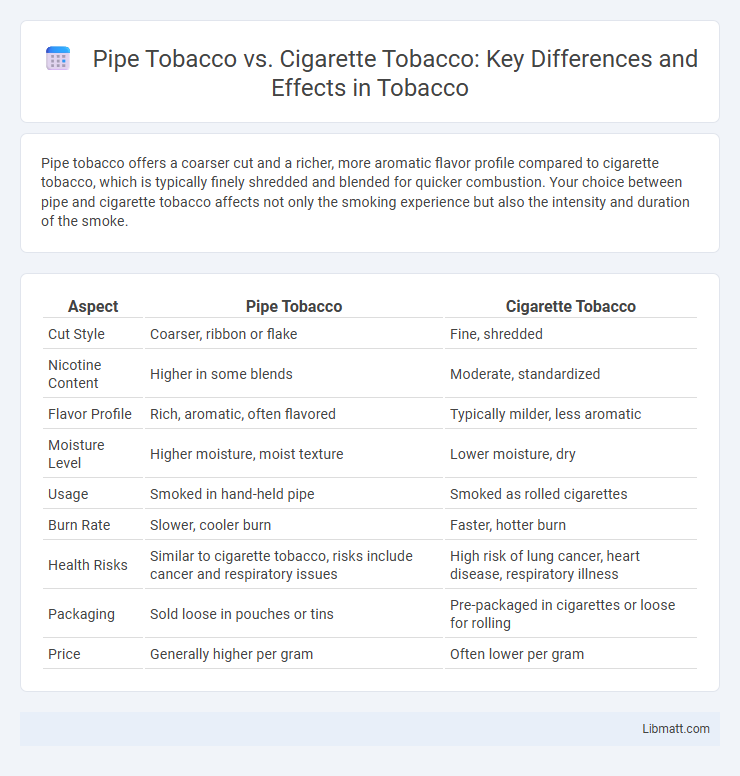Pipe tobacco offers a coarser cut and a richer, more aromatic flavor profile compared to cigarette tobacco, which is typically finely shredded and blended for quicker combustion. Your choice between pipe and cigarette tobacco affects not only the smoking experience but also the intensity and duration of the smoke.
Table of Comparison
| Aspect | Pipe Tobacco | Cigarette Tobacco |
|---|---|---|
| Cut Style | Coarser, ribbon or flake | Fine, shredded |
| Nicotine Content | Higher in some blends | Moderate, standardized |
| Flavor Profile | Rich, aromatic, often flavored | Typically milder, less aromatic |
| Moisture Level | Higher moisture, moist texture | Lower moisture, dry |
| Usage | Smoked in hand-held pipe | Smoked as rolled cigarettes |
| Burn Rate | Slower, cooler burn | Faster, hotter burn |
| Health Risks | Similar to cigarette tobacco, risks include cancer and respiratory issues | High risk of lung cancer, heart disease, respiratory illness |
| Packaging | Sold loose in pouches or tins | Pre-packaged in cigarettes or loose for rolling |
| Price | Generally higher per gram | Often lower per gram |
Introduction to Pipe Tobacco vs Cigarette Tobacco
Pipe tobacco features a coarser cut and often includes a blend of aromatic flavors designed for slower, cooler smoking experiences, contrasting with cigarette tobacco's finer cut and additives optimized for quick ignition and consistent burn. The chemical composition in pipe tobacco tends to have fewer additives, influencing taste and nicotine delivery, while cigarette tobacco is engineered for uniformity and mass production. Understanding these differences is crucial for discerning smokers seeking distinct sensory profiles and smoking rituals.
Key Differences in Leaf Selection
Pipe tobacco uses more whole, unprocessed leaves that often come from specific parts of the tobacco plant to create richer, more complex flavors. Cigarette tobacco typically involves finely cut, shredded leaves mixed with additives to ensure consistent burning and a milder taste. Your choice between pipe and cigarette tobacco influences the leaf texture, cut, and flavor profile you experience.
Processing Methods: Pipe vs Cigarette Tobacco
Pipe tobacco undergoes a slow curing process involving air, fire, or flue curing to retain moisture and develop rich flavors, often resulting in coarser cuts and blends tailored for slow burning. Cigarette tobacco is typically flue-cured or blended with additives, then finely chopped to ensure uniformity and quick combustion suitable for mass production and consistent smoking experience. The distinct processing methods directly influence the moisture content, flavor profile, and combustion rate of pipe versus cigarette tobacco.
Flavors and Aromatics Comparison
Pipe tobacco typically offers a richer variety of flavors and aromatics, often infused with ingredients like vanilla, cherry, and whiskey, producing a smoother, more nuanced smoking experience. Cigarette tobacco tends to have a more straightforward, harsher taste with fewer aromatic additives, focusing primarily on nicotine delivery rather than flavor complexity. The curing process for pipe tobacco enhances its aromatic qualities, making it favored by smokers seeking diverse and distinctive sensory profiles.
Additives and Chemicals Used
Pipe tobacco generally contains fewer additives compared to cigarette tobacco, which is often treated with numerous chemicals to enhance flavor, control burn rate, and increase nicotine delivery. Cigarette tobacco may include additives such as ammonia compounds, sugars, and humectants that can alter the chemical composition and toxicity of the smoke. Understanding these differences in additives helps you make informed choices about the potential health impacts of each smoking option.
Preparation and Smoking Techniques
Pipe tobacco requires a more deliberate preparation process involving packing the bowl evenly and lighting it carefully to ensure an even burn, while cigarette tobacco is pre-rolled for instant use. Smoking a pipe often involves slower, more contemplative puffs to maintain cool smoke and avoid tongue bite, contrasting with the quicker, consistent draws typical of cigarettes. Your smoking experience can become richer with pipe tobacco due to the nuanced packing and lighting methods that influence flavor and burn time.
Health Risks and Considerations
Pipe tobacco generally contains higher levels of nicotine and tar compared to cigarette tobacco, increasing the risk of developing respiratory and cardiovascular diseases. While some believe pipe smoking is less harmful, studies show it still delivers significant amounts of carcinogens, raising the risk of cancers, especially oral and lung cancer. Your health risks remain substantial regardless of the tobacco type, emphasizing the importance of understanding these dangers before use.
Cultural and Historical Perspectives
Pipe tobacco holds a rich cultural heritage that dates back centuries, often associated with ceremonial use and leisurely social rituals across Indigenous, European, and Asian societies. Cigarette tobacco, by contrast, rose to prominence in the 20th century as a mass-produced commodity tied to industrialization and modern consumer culture. Your understanding of these distinct cultural and historical perspectives highlights the diverse roles tobacco has played in shaping social customs and traditions worldwide.
Cost and Availability
Pipe tobacco typically costs less per ounce than cigarette tobacco due to its bulk packaging and lower taxes. Availability varies widely depending on location, with pipe tobacco often found in specialty tobacconists or online, whereas cigarette tobacco is more commonly sold in convenience stores and supermarkets. When choosing your tobacco, consider that pipe tobacco may require more effort to purchase but can offer long-term savings.
Which Should You Choose: Pipe or Cigarette Tobacco?
Choosing between pipe tobacco and cigarette tobacco depends largely on personal preference and usage style. Pipe tobacco tends to offer a richer, more complex flavor profile and typically contains a higher moisture content, allowing for slower, cooler smoking sessions. Cigarette tobacco is often more processed, designed for quicker consumption with additives enhancing burn rate and nicotine delivery, making it more convenient but less nuanced in taste.
pipe tobacco vs cigarette tobacco Infographic

 libmatt.com
libmatt.com